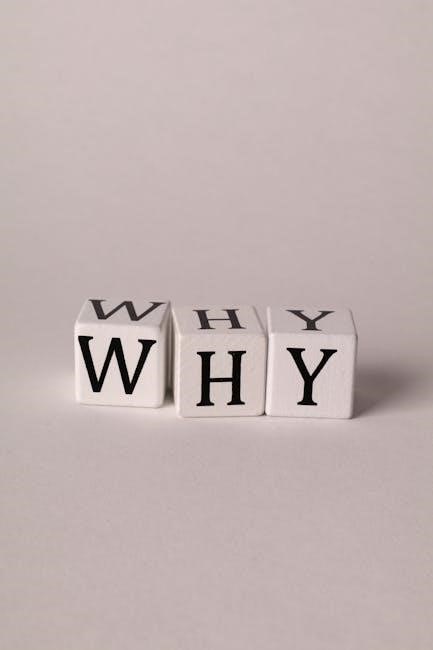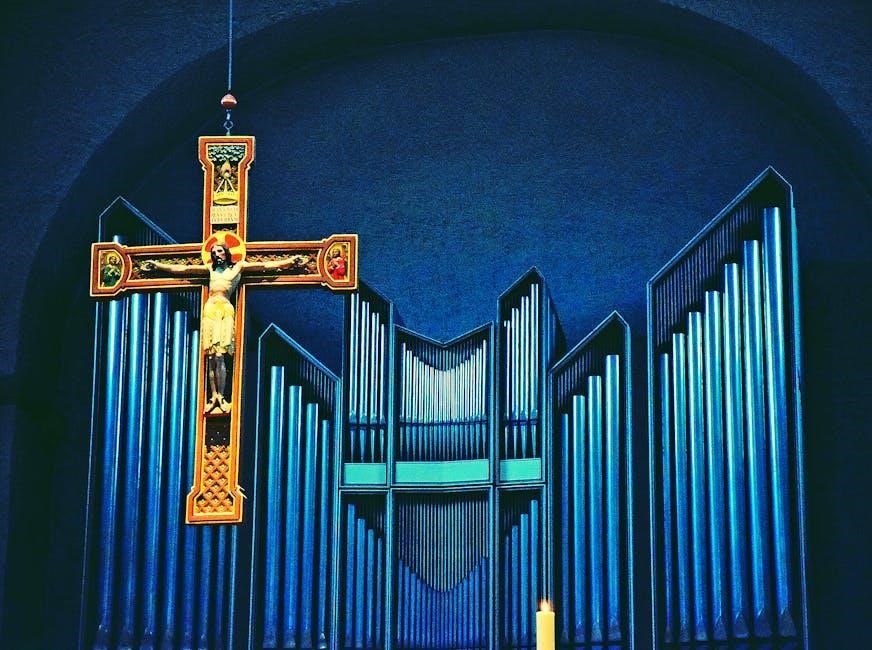Chapter 4 of Lord of the Flies explores the boys’ descent into savagery, highlighting leadership struggles, moral dilemmas, and the erosion of civilization. It sets the stage for the novel’s darker themes.
Overview of Lord of the Flies and Chapter 4
Lord of the Flies, by William Golding, explores human nature through stranded boys on an island. Chapter 4, “Painted Faces and Long Hair,” marks a turning point as the boys’ savagery grows. Jack embracing face paint symbolizes his descent into primal instincts, while the signal fire’s neglect highlights their fading hope for rescue. This chapter underscores the conflict between civilization and savagery, setting the stage for the novel’s darker themes and the boys’ moral unraveling.
Significance of Chapter 4 in the Novel
Chapter 4 is pivotal as it marks the boys’ gradual shift from civility to savagery. Jack’s embrace of face paint symbolizes his descent into primal instincts, while the signal fire’s neglect underscores the group’s diminishing hope for rescue. This chapter reveals internal conflicts, such as Ralph’s struggle to maintain order and Jack’s growing obsession with hunting. It also highlights Simon’s emerging insight into the true nature of the “beast,” foreshadowing later revelations. The events of this chapter set the stage for the novel’s exploration of human nature’s darker aspects, making it a crucial turning point in the narrative.

Key Questions and Answers from Chapter 4
Chapter 4 answers key questions about the boys’ behavior, revealing Jack’s embrace of savagery, the signal fire’s neglect, and Ralph’s struggling leadership, while Simon’s wisdom emerges.
What does the chapter reveal about Simon’s personality?
Chapter 4 highlights Simon’s compassionate and insightful nature. He shows empathy by sharing meat with Piggy, despite Jack’s disapproval, demonstrating his kindness and moral integrity. Simon’s solitude reflects his deep thinking and sensitivity, as he often seeks isolation to contemplate. His actions reveal a sense of justice and understanding, positioning him as a voice of reason amidst the group’s growing chaos. Simon’s personality contrasts sharply with the escalating savagery around him.
How does Jack’s behavior evolve in this chapter?
Jack’s behavior in Chapter 4 becomes increasingly aggressive and power-hungry. He prioritizes hunting over maintaining the signal fire, showcasing his growing obsession with savagery. Jack’s defiance toward Ralph intensifies, and he openly challenges Ralph’s authority. His decision to wear face paint symbolizes his embrace of primal instincts. Jack’s actions reveal a shift from teamwork to self-serving ambition, as he disregards the group’s needs and assaults Piggy, demonstrating his escalating ruthlessness and desire for dominance.
What happens to the signal fire?
In Chapter 4, the signal fire, crucial for rescue, goes out because the hunters, including Jack, abandon their duty to maintain it. This negligence occurs as Jack focuses on hunting, prioritizing primal instincts over civilization. The fire’s extinction symbolizes the boys’ regression into savagery and their diminishing hope for rescue. Ralph and Piggy express frustration, highlighting the growing divide between those who value order and those embracing chaos. The incident underscores the group’s moral decay and the fading grip on civilized behavior.
How does Ralph reassert his authority?
Ralph reasserts his authority by confronting Jack about the signal fire going out, emphasizing its importance for their rescue. He calls a meeting using the conch shell, reminding the group of their priorities and rules. Ralph’s firm stance highlights his commitment to order and survival, countering Jack’s growing influence. This moment underscores Ralph’s leadership struggles and his effort to maintain control amidst the group’s declining discipline.
What role does the conch shell play?
The conch shell serves as a symbol of order and democracy, allowing the holder to speak without interruption. Ralph uses it to call meetings and maintain control, emphasizing its importance for decision-making. The conch represents civility and unity, contrasting with the group’s growing savagery. Its role in Chapter 4 highlights Ralph’s efforts to uphold order and leadership, showcasing its significance as a tool for maintaining their fragile society and moral structure.

Themes in Chapter 4
The chapter delves into themes of savagery vs. civilization, leadership struggles, and guilt. It highlights the boys’ descent into primal behavior, power conflicts, and moral awareness.
Savagery vs. Civilization
In Chapter 4, Jack’s embrace of face paint symbolizes his descent into savagery, contrasting with Ralph’s efforts to maintain civilization. The signal fire, a lifeline to rescue, is neglected as the boys prioritize hunting. This reflects the internal conflict between primal instincts and societal norms. Jack’s transformation highlights the blurred lines between civilized behavior and raw savagery, foreshadowing the group’s moral decay. The chapter underscores the tension between order and chaos, as the boys’ primal nature begins to dominate.
Leadership and Power Struggles
Ralph and Jack’s conflicting priorities ignite tension in Chapter 4. Ralph emphasizes rules and the signal fire, while Jack prioritizes hunting, challenging Ralph’s authority. The conch shell, a symbol of democratic order, begins to lose its influence as Jack’s defiance grows. This power struggle highlights the boys’ evolving attitudes toward leadership, with Jack’s aggressive pursuit of dominance contrasting Ralph’s more civilized approach. The chapter underscores the fragility of authority and the rise of rebellion, foreshadowing deeper conflicts.
Guilt and Conscience
In Chapter 4, guilt and conscience emerge as significant themes. Maurice feels remorse for kicking sand in Percival’s eyes, showing a lingering sense of morality. Simon, embodying innocence, shares meat with Piggy despite Jack’s disapproval, highlighting his ethical awareness. These moments contrast with the boys’ growing savagery, illustrating the internal conflict between conscience and primal instincts. The chapter reveals how guilt fades as the boys’ civilized norms erode, foreshadowing moral decay and the loss of individual accountability.

Character Development
Chapter 4 highlights Jack’s evolving savagery, Simon’s insight and isolation, and Ralph’s struggle to maintain order, revealing deeper layers of their personalities and leadership dynamics.
Ralph’s Leadership Challenges
Ralph faces increasing difficulties as Jack’s defiance grows. His authority is questioned when the signal fire goes out, leading to frustration and a struggle to maintain discipline among the group. Ralph’s efforts to enforce rules and prioritize rescue are undermined by the boys’ growing interest in hunting and savagery, highlighting his internal conflict between leadership and the island’s primal influences.
Jack’s Descent into Savagery
Jack’s behavior in Chapter 4 marks a noticeable shift toward savagery. His face paint symbolizes his embrace of primal instincts, and his aggression toward Piggy highlights his growing disregard for rules. Jack’s obsession with hunting and his defiance of Ralph undermine the group’s cohesion, showcasing his transformation from a reluctant follower to a power-hungry leader. His actions foreshadow a deeper descent into brutality, driven by his desire for control and dominance over the island.
Simon’s Insight and Isolation
Simon’s quiet nature and introspective personality set him apart from the others. His actions, such as sharing meat with Piggy despite Jack’s disapproval, reveal his inherent kindness and moral awareness. Simon’s isolation stems from his epilepsy and the boys’ fear of his differences, limiting his ability to influence the group. His insightful observations, however, hint at a deeper understanding of the island’s true nature, showcasing his unique perspective amidst the chaos. His isolation underscores his tragic role in the novel.

Symbolism in Chapter 4
Chapter 4 is rich in symbolic elements, such as the conch shell representing order and democracy, while Jack’s face paint signifies his embrace of savagery and power struggles.
The Conch Shell
The conch shell symbolizes democracy, order, and civilized discourse in Chapter 4. It is used to call meetings and grant speaking rights, emphasizing equality among the boys. However, as the chapter progresses, the conch’s power wanes, reflecting the group’s slide into chaos. Ralph relies on it to maintain authority, but its influence diminishes as Jack’s savagery grows. The conch represents the fragile grip of civilization, highlighting the tension between order and primal instincts.
Face Paint and Masks
In Chapter 4, Jack uses face paint to disguise himself during hunts, symbolizing his embrace of savagery and separation from civility. The mask hides his identity, empowering him to act more aggressively and primal. This transformation reflects his growing obsession with hunting and power, distancing him from Ralph’s leadership. The face paint also signifies Jack’s desire to shed societal constraints, embracing a primal identity that fosters fear and control over others on the island.
The Signal Fire
The signal fire, a symbol of hope and rescue, goes out in Chapter 4 due to the boys’ negligence. Jack’s hunters abandon their duty to maintain it, prioritizing the thrill of hunting over rescue efforts. This negligence underscores the group’s shifting priorities and the erosion of their civilized values. The extinguished fire symbolizes the loss of their connection to society and their descent into chaos, foreshadowing further divisions and the island’s darker fate.

The Role of the Littluns
The littluns’ activities, like building sandcastles, highlight their innocence and vulnerability. Their presence underscores the group’s dynamic, as their helplessness often sparks tension among the older boys.
Activities and Behavior
The littluns engage in playful activities like building sandcastles, showcasing their innocence. However, their vulnerability is exposed as older boys, such as Maurice and Roger, destroy their creations. Their behavior reflects a desire for normalcy and childhood joy, contrasting with the island’s growing savagery. This highlights their role as symbols of innocence and victims of the group’s deteriorating morals, emphasizing their impact on the novel’s themes of societal breakdown and loss of innocence.
Influence on the Group Dynamics
The littluns’ vulnerability and fear amplify tension within the group, as their dependence on others highlights power imbalances. Their presence accelerates the group’s moral decay, as older boys exploit their innocence. The littluns’ activities, though innocent, inadvertently expose the fragile social structure, fostering resentment and competition. This dynamic underscores the novel’s exploration of savagery and civilization, revealing how their vulnerability shapes the boys’ behavior and leadership struggles, ultimately contributing to the island’s chaotic descent.
Chapter 4 highlights the boys’ descent into savagery, with Jack’s face paint symbolizing his primal transformation. The signal fire’s extinction and Ralph’s struggling leadership underscore the group’s moral decline.
Key Events and Plot Points
In Chapter 4, Jack’s obsession with hunting intensifies as he wears face paint, symbolizing his descent into savagery. The signal fire, crucial for rescue, is neglected and extinguished, highlighting the boys’ shifting priorities. Ralph confronts Jack about his irresponsibility, revealing growing tensions in their leadership rivalry. Simon, in an act of kindness, shares meat with Piggy despite Jack’s disapproval, showcasing his compassionate nature. The conch shell’s influence begins to wane as chaos and disorder prevail.
Impact on the Novel’s Progression
Chapter 4 accelerates the novel’s downward spiral, as the signal fire’s extinction symbolizes the boys’ drift away from civilization. Jack’s defiance and Ralph’s weakening authority foreshadow deeper conflicts. The conch’s diminishing influence highlights the erosion of order, while Simon’s isolated kindness contrasts with the group’s moral decay. These events escalate tensions, setting the stage for the tragic outcomes and thematic exploration of savagery, power, and humanity’s fragile nature.

Comprehension Questions
What activities do the littluns engage in? Why does Jack wear face paint? What role does Simon play? How does the signal fire’s extinction impact the group?
Describe the littluns’ activities.
The littluns spend their time building sandcastles and engaging in imaginative play. They are often seen gathered on the beach, creating structures and enjoying carefree moments. However, their fun is disrupted when Maurice and Roger destroy their castles, highlighting the growing tension and bullying among the group. The littluns’ activities symbolize innocence and the fleeting nature of childhood in the face of encroaching savagery.
Why does Jack wear face paint?
Jack wears face paint to disguise himself during hunts, believing it makes him more intimidating and effective. The paint symbolizes his transformation from a civilized boy to a savage hunter. It hides his identity, allowing him to embrace primal instincts and assert dominance, reflecting his growing obsession with power and control over the group.
What is Simon’s role?
Simon plays a pivotal role as the insightful and isolated figure in Chapter 4. He demonstrates kindness by sharing meat with Piggy, despite Jack’s disapproval, showcasing his moral compass. Simon’s actions highlight his deep understanding of the island and its true nature, contrasting with the growing savagery around him. His isolated reflections foreshadow his later revelations, making him a key figure in unraveling the mysteries of the island and the boys’ primal descent.

Moral and Ethical Dilemmas
In Chapter 4, the boys face moral dilemmas like prioritizing hunting over rescue, leading to ethical conflicts and strained relationships, reflecting their internal struggles and broader societal impacts.
Choices and Consequences
In Chapter 4, the boys’ choices, like neglecting the signal fire for hunting, lead to severe consequences, such as missed rescue opportunities and heightened tensions among the group. Jack’s aggressive behavior escalates conflicts, while Simon’s decision to share meat despite opposition highlights his moral integrity, isolating him further. These choices underscore the novel’s exploration of human nature, where actions driven by desire for power or survival ripple through the group, shaping their collective fate and individual relationships.
Impact on Character Relationships
Chapter 4 strains relationships as Ralph and Jack’s conflict over responsibility intensifies, while Simon’s quiet wisdom isolates him further. The hunters’ loyalty shifts toward Jack, creating division. Ralph’s frustration with Jack’s recklessness highlights their growing mistrust. Simon’s kindness to Piggy despite Jack’s opposition underscores his moral strength but deepens his isolation. The littluns’ fear of abandonment adds emotional tension, as their reliance on Ralph grows. These interactions reveal the fragile bonds and emerging hostility among the group.
Chapter 4 marks a pivotal shift in the boys’ descent into savagery, highlighting leadership conflicts and moral decay. It underscores the novel’s exploration of human nature and civility’s fragility.
Final Thoughts on Chapter 4
Chapter 4 of Lord of the Flies is pivotal, showcasing the boys’ descent into savagery and moral decay. Jack’s embrace of hunting and face paint symbolizes his growing primal instincts, while Ralph’s struggle to maintain order highlights the clash between civilization and chaos. The extinguished signal fire and Simon’s isolation foreshadow darker events, emphasizing the novel’s exploration of human nature and the fragility of societal norms. This chapter underscores the themes of power, guilt, and the erosion of innocence.
Importance in the Context of the Novel
Chapter 4 is a turning point, highlighting the boys’ moral decline and the rise of savagery. Jack’s obsession with hunting and face paint symbolizes his primal transformation, while Ralph’s struggle to maintain order reveals the fragility of leadership. The extinguished signal fire underscores the consequences of neglecting civilization, foreshadowing the novel’s tragic progression. This chapter deepens themes of power, guilt, and the erosion of innocence, making it crucial for understanding the novel’s exploration of human nature.
